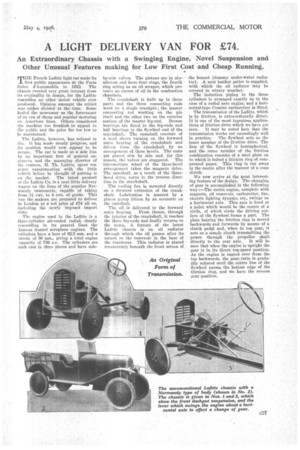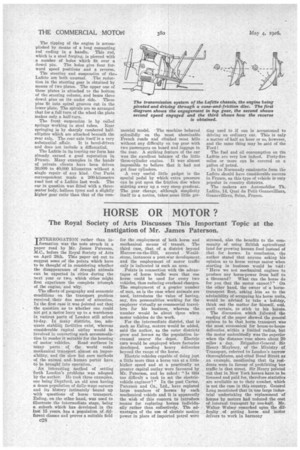A LIGHT DELIVERY VAN FOR £74.
Page 11

Page 12

If you've noticed an error in this article please click here to report it so we can fix it.
An Extraordinary Chassis with a Swinging Engine, Novel Suspension and Other Unusual Features making for Low First Cost and Cheap Running.
TIIE French Lafitte light car made its first public appearance at the Paris Salon d'AutoMobile in 1023. The chassis created very great interest from its originality in design, for the Lafitte resembles no other motor vehicle ever produced. Opinion amongst the critics was rather divided at the time. Some hailed the newcomer as the forerunner of an era of cheap and popular motoring on American lines. Others considered the machine too freakish to appeal to the public and the price far too low to be maintained.
The Lafitte; however, has refused to die. It has made steady progress, and its position would . now appear to be secure. The car is made as a side line by an important firm of geueral engineers. and the managing director of the concern, M. Th. Lafitte, spent ten years experimenting with the little vehicle before. he thought of putting it On the market. The latest product of the Lafitte Co. is a neat little delivery wagon on the lines of the popular Normandy eamionette, capable of taking from 3 cwt. to 4 cwt of goods. This van the makers are prepared to deliver in London at a net price of £74 all on, including the newly imposed import duty.
The engine used in the Lafitte is a three-cylinder air-cooled radial, closely resembling in its general lines the famous Anzani aeroplane engines. The cylinders haves bore of 62.5 ram. and a stroke of 80 mm., giving a total engine capacity of 736 c.c. The cylinders are each cast in three pieces and have side by-side valves. The pistons are in aim-minium and have four rings, the fourth ring acting-as an oil scraper, which prevents an excess of oil in the combustion chambers.
The crankshaft is built up in three parts and the three connecting rods work on a single crankpin; the master connecting rod working on the pin itself and the other two on the exterior surface of the master big-end. Bronze bearings are fitted to the big-ends and ball bearings to the flywheel end of the crankshaft. The camshaft consists of a Steel sleeve turning on the forward main bearing of the crankshaft and driven from the crankshaft by an arrangement of three bevels. The cams are placed side by side and, for this reason, the valves are staggered. The intermediate wheel of the three-bevel arrangement takes the magneto drive. The camshaft. as a result of the threebevel drive, turns in the reverse direction to the crankshaft.
' The cooling fan is mounted directly on a forward extension of the crankshaft. Lubrication is assured by a piston pump driven by an eccentric on the camshaft.
The oil is delivered to the forward main bearing. From thence, through the interior of the crankshaft, it reaches the three big-ends and finally returns to the sump, A feature of the latest .Lafitte chassis is an oil radiator through which the oil passes after its. return to the reservoir in the base of the crankcase. This radiator is placed transversely beneath the front screen of the' bonnet (dummy under-water radiator). A neat leather gaiter is supplied, with which the oil radiator may be covered in wintry weather.
The induction piping to the three cylinders is arranged exactly nts in the case of a radial aero engine, and a horizontal-type Cozette carburetter is fitted.
The transmission of the Lafitte, which is by friction, is extraordinarily direct. It is one of the most ingenious applicae tions of friction drive which we have yet seen. It may be noted here that the transmission works out exceedingly well in practice. The flywheel acts as the inner member of the friction drive. The face of the flywheel is hemispherical, and the outer member of the friction combination consists of a steel plate on to which is bolted a friction ring of compressed paper. This ring is cut away in the centre after the manner of a cone
clutch. • We now arrive at the most interesting feature of the design. The changing of gear is accomplished in the following way ;—The entire engine, complete with magneto, oil reservoir, carburetter, fan, electric lighting dynamo, etc., swings on a horizontal axis. This axis is fixed at a point which would be the centre of a cirele, of which circle the driving surface of th'e flywheel forms a part. The plate bearing the friction ring is moved backwards and forwards by means of a clutch pedal and, 'when in top gear, it acts as a simple clutch transmitting the. power through the propeller shaft directly to the rear axle. It will be seen that when the engine is upright the gear is in its direct top-speed position. As the engine is canted over from the top backwards, the gear. ratio is gradually reduced until the centre line of the flywheel passes the bottom edge of the friction ring, and we have the reverse gear position. The tipping of the engine is accomplished by means of a long connecting rod ending in a handle. This rod, which is a steel forging, is pierced with a number of holes which fit over a dowel pin. The holes give four forward speed positions and a reverse.
The steering and suspension of the. Lafitte are both unusual. The Deduction in the steering gear is obtained by means of two plates. The upper one of these plates is attached to the bottom of the steering column, and bears three dowel pins on its under side. These pins 'fit into spiral grooves cut in the lower plate. The spirals are so arranged that for a full turn of the wheel the plate makes only a half-turn.
The front suspension is by coiled springs working in steel tubes. Rear springing is by sharply cambered halfelliptics which are attached beneath the rear axle. The rear axle itself is a very substantial affair. It is bevel-driven and does not include a differential.
The Lafitte in its touring car form has already earned a goad reputation in France. Many examples in the hands of private clients have been driven 30,000 to 40,000 kilometres without a single repair of any kind. Our Paris correspondent made a 200-kilometre road test of a Lafitto last week. The ear in question was fitted with a threeReenter body, balloon tyres and a slightly higher gear ratio than that of the corn
mercial model. The machine behaved splendidly on the most abominable French roads and climbed most hills without any difficulty on top gear with two passengers on board and luggage in the roar. A. striking feature of the car was the excellent balance of the little throe-cylinder engine. It was almost impossible to believe that it had not got four cylinders.
A very useful little gadget is the special pedal by which extra pressure can be put upon the friction disc when starting away up a very steep gradient. The gear change, although simplicity itself to a novice, takes some little get
ting used to if one is accustomed to driving an ordinary ear. This is only a matter of half an hour or so, however, and the same thing may be said of the Ford!
The fuel and oil consumption on the Lafitbe are very low indeed. Forty-five miles or more can be covered on a gallon of petrol. In its Normandy eausionctte form the Lafitte should have considerable success in France, as this type of vehicle is very popular iu country districts.
The makers are Automobiles Th. Lafitte, 14, Quad du Petit Gennevilliers, Gennevilliers, Seine, France.
































